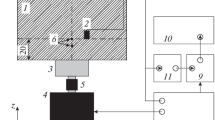Abstract
The purpose of this study was to clarify the performance of transducers for the mechanical characterization of muscle and subcutaneous tissue with the aid of a system identification technique. The common peroneal nerve was stimulated, and a mechanomyogram (MMG) of the anterior tibialis muscle was detected with a laser displacement meter or an acceleration sensor. The transfer function between stimulation and the MMG was identified by the singular value decomposition method. The MMG detected with a laser displacement meter, DMMG, was approximated with a second-order model, but that detected with an acceleration sensor, AMMG, was approximated with a sixth-order model. The natural frequency of the DMMG coincided with that in the literature and was close to the lowest natural frequency of the AMMG. The highest natural frequency of the AMMG was within the range of the resonance frequencies of human soft tissue. The laser displacement meter is suitable for the precise identification of the MMG, which has a natural frequency of around 3 Hz. The acceleration transducer is suitable for the identification of the MMG with natural frequencies of tens of hertz.





Similar content being viewed by others
References
An KN, Hui FC, Morrey BF, Linscheid RL, Chao EY (1981) Muscles across the elbow joint: a biomechanical analysis. J Biomech 14:659–669
Baratta R, Solomonow M (1990) The dynamic response model of nine different skeletal muscles. IEEE Trans Biomed Eng 37:243–251
Baratta RV, Solomonow M, Zhou B-H (1998) Frequency domain-based models of skeletal muscle. J Electromyogr Kinesiol 8:79–91
Barry DT, Cole NM (1988) Fluid mechanics of muscle vibrations. Biophys J 53:899–905
Bawa P, Stein RB (1976) Frequency response of human soleus muscle. J Neurophysiol 39:788–793
Beck TW, Housh TJ, Johnson GO, Weir JP, Cramer JT, Coburn JW, Malek MH (2006) Comparison of a piezoelectric contact sensor and an accelerometer for examining mechanomyographic amplitude and mean power frequency versus torque relationships during isokinetic and isometric muscle actions of the biceps brachii. J Elecromyogr Kinesiol 16:324–335
Cramer JT, Housh TJ, Weir JP, Johnson GO, Berning JM, Perry SR, Bull AJ (2004) Gender, muscle, and velocity comparisons of mechanomyographic and electromyographic responses during isokinetic muscle actions. Scand J Med Sci Sports 14:116–127
Evetovich TK, Housh TJ, Stout JR, Johnson GO, Smith DB, Ebersole KT (1997) Mechanomyographic responses to concentric isokinetic muscle contraction. Eur J Appl Physiol 75:166–169
Fukunaga T, Roy RR, Shellock FG, Hodgson JA, Day MK, Lee PL, Kwong-Fu H, Edgerton VR (1992) Physiological cross-sectional area of human leg muscles based on magnetic resonance imaging. J Orthop Res 10:926–934
Irie T, Oka H, Yamamoto T (1992) Meaning of measured results of biomechanical impedance and the stiffness index. IEICE Trans D-II J75-D-II:947–955 (in Japanese)
Kaczmarek P, Celichowski J, Drymała-Celichowska H, Kasiński A (2009) The image of motor units architecture in the mechanomyographic signal during the single motor unit contraction: in vivo and simulation study. J Electromyogr Kinesiol 19:553–563
Kung S (1979) A new identification and model reduction algorithm via singular value decomposition. In: Proceedings 12th Asilomar Conference on circuits, Systems and Computers, pp 705–714
Orizio C, Baratta RV, Zhou BH, Solomonow M, Veicsteinas A (1999) Force and surface mechanomyogram relationship in cat gastrocnemius. J Electromyogr Kinesiol 9:131–140
Orizio C, Solomonow M, Diemont B, Gobbo M (2008) Muscle-joint unit transfer function derived from torque and surface mechanomyogram in humans using different stimulation protocols. J Neurosci Meth 173:59–66
Petitjean M, Maton B (1995) Phonomyogram from single motor units during voluntary isometric contraction. Eur J Appl Physiol 71:215–222
Shinohara M, Kouzaki M, Yoshihisa T, Fukunaga T (1997) Mechanomyography of the human quadriceps muscle during incremental cycle ergometry. Eur J Appl Physiol 76:314–319
Uchiyama T, Hashimoto E (2011) System identification of the mechanomyogram from single motor units during voluntary isometric contraction. Med Biol Eng Comput 49:1035–1043
Van der Veen A-J, Deprettere EF, Swindlehurst AL (1993) Subspace-based signal analysis using singular value decomposition. Proc IEEE 81:1277–1308
Watakabe M, Mita K, Akataki K, Itoh Y (2001) Mechanical behavior of condenser microphone in mechanomyography. Med Biol Eng Comput 39:195–201
Watakabe M, Itoh Y, Mita K, Akataki K (1998) Technical aspects of mechanomyography recording with piezoelectric contact sensor. Med Biol Eng Comput 36:557–561
Zhou B-H, Solomonow M, Baratta R, D’Ambrosia R (1995) Dynamic performance model of an isometric muscle-joint unit. Med Eng Phys 17:145–150
Acknowledgments
This work was supported by a Grant-in-Aid for Scientific Research.
Author information
Authors and Affiliations
Corresponding author
Rights and permissions
About this article
Cite this article
Uchiyama, T., Shinohara, K. Comparison of displacement and acceleration transducers for the characterization of mechanics of muscle and subcutaneous tissues by system identification of a mechanomyogram. Med Biol Eng Comput 51, 165–173 (2013). https://doi.org/10.1007/s11517-012-0981-x
Received:
Accepted:
Published:
Issue Date:
DOI: https://doi.org/10.1007/s11517-012-0981-x




